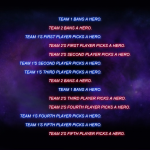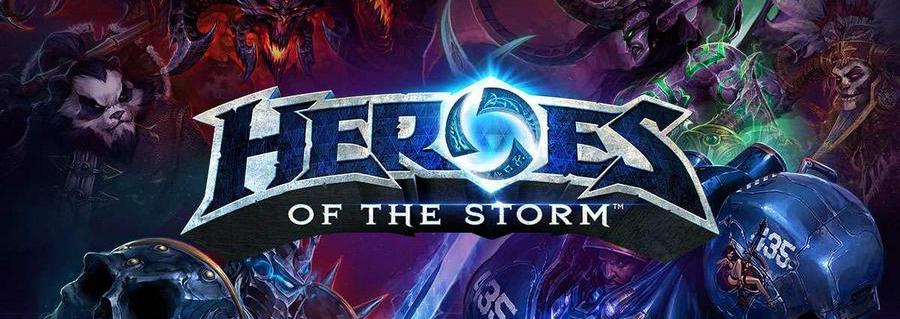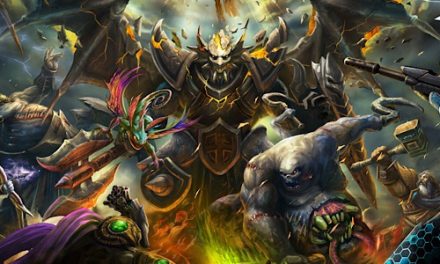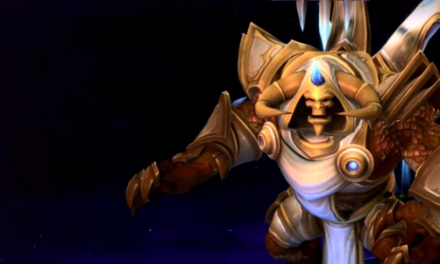Recently some friends have encouraged me to play Heroes of the Storm (HOTS) with them, in the eventual goal to have a well-rounded 5-person team that can compete in online tournaments. I had the idea to post updates about how the journey has been thus far, and realized that an explanation is in order – with the explosive growth of competitive “e-sports” in recent years, many of the competitive games played online today are almost impossible to compare to the games of my youth.
Heroes of the Storm – Game Objectives
By and large, every map in HOTS has the same end goal: break through the other team’s defenses and inflict enough damage on their “core” building to destroy it, before they can destroy yours. Each team consists of five players, each controlling a unique character. Your core spawns very weak but ultimately useful minions to help deal damage to enemy structures, and there are various mercenaries and optional objectives placed around each map. In order to win, particularly at the mid- or high-tier of play, teams have to communicate, strategize, and have a very good handle on both the mechanics of their characters as well as those of the other team. Unlike other lane-defense games (League of Legends and DOTA are the two most popular), the fate of a game can turn even vary late in the match, and I’ve seen teams pull up amazing upsets with well-timed last-minute plays.
As the game progresses, characters unlock new abilities and the overall power of minions, mercenaries, and map objectives increase – a big, burly NPC monster may be little more than a nuisance at the 5 minute mark, but could become a neigh-unstoppable juggernaut in the 25th minute. Character respawn times increase as well, meaning a late-game death can take a player out of the fight for more than a minute, severely hampering their team. Eventually, whether through direct damage or with the help of map mechanics, one team will do enough damage to the other’s core to end the game.
Character Roles
Almost all of the characters available for play have made previous appearances in other Blizzard games, from Diablo III and StarCraft 2 to more esoteric entries like The Lost Vikings. Each individual character fulfills at least one of the following roles, when it comes to team composition. Each character has various strengths and weaknesses which help them excel on different maps or against different foes, but most teams are made up with at least one character from each of the following categories:
- Support – Typically the team healer, the support’s role is to do everything they can to make sure other characters don’t die
- Tank – Able to absorb a great deal of punishment, these characters often form the front lines, choosing which targets the rest of the team attacks
- Bruiser – Pure damage-dealing goodness. Each Bruiser has their own special abilities and quirks, but their primary focus is to attack and ultimately kill characters that step out of position or extend too far
- Specialist – The wild-card. Characters that fit into this category have unique ability sets that separate them from the other categories. This could be different ways of supporting characters that aren’t straight healing, summoning their own minion assistants, or dedicated to controlling large sections of the battlefield
With each team having 5 characters, it’s very common to see one Support, one Specialist, and the rest spread between Tanks and Bruisers. Occasionally there are game matchups which don’t include all of the roles, and those make for very unique situations – playing a tank without a healer necessitates a very different playstyle, for example.
Game Types
HOTS has many different settings and predefined game variables, but largely when I talk about gameplay I’ll be referring to one of two game modes, which differ largely in how characters are selected, and make for very distinct play and strategy:
- Quick Match – Pick your character, optionally pick some friends to join up, and the game’s internal algorithms will find other people to play with and against, on a map chosen out of a predefined list. The biggest draw of this game type is that you can define your personal or team composition before jumping into the game, though you run the risk of a character being very ill-suited for the randomly-determined map
 League Play – Aside from being ranked in a worldwide leaderboard, League Play differs from Quick Match in that you do not select a character before joining the game. Two teams of five players are matched up, a map is chosen, and then the two teams engage in a back-and-forth process of banning certain characters and selecting other ones. This means that characters which excel on one map or another may be banned from being chosen, or that one team may select a particular hero not necessarily because they want it, but because they don’t want the other team to have it. You can see the image at the right for an example of the draft order.
League Play – Aside from being ranked in a worldwide leaderboard, League Play differs from Quick Match in that you do not select a character before joining the game. Two teams of five players are matched up, a map is chosen, and then the two teams engage in a back-and-forth process of banning certain characters and selecting other ones. This means that characters which excel on one map or another may be banned from being chosen, or that one team may select a particular hero not necessarily because they want it, but because they don’t want the other team to have it. You can see the image at the right for an example of the draft order.
Quick Match is a great game-mode for casual play, for testing out different team compositions, and learning game mechanics, and I use it quite a bit when I want to focus on developing my skills on a particular character or don’t feel like risking my world ranking with unknown teammates. That said, the majority of our practice has been in League Play, since that’s the format used by amateur and professional tournaments.
My Role(s)
Originally introduced to the game by playing Specialists (often with the directive “go over there and don’t die while we do the hard work”), recently my regular team has noticed I have an affinity for playing Tanks, and want to encourage me to play more of them, freeing up experienced players for more nuanced roles like Support and Bruiser. Currently HOTS has more than 80 different characters available to play, and though I either own or have experience with more than half of them, usually my character selection is reduced to the following options, as they synergize best with my teammate’s regular characters:
- Murky or Nazeebo – Specialist heroes, Murky has very low survivability which is offset by having the fastest respawn time of any character. More a nuisance than a real threat, he nevertheless can make a huge dent in the enemy team’s defenses if left alone. Nazeebo commands undead and uses them to push enemies out of different parts of the map, though he gets in real trouble if pressured by Bruisers.
- Diablo or Johanna – Tanks, Diablo provides a good amount of initiate, or the ability to start a worthwhile fight. The longer he survives the larger his health pool gets, so he can be a very tough cookie as the game progresses. Johanna has one of the least amount of damage output in the game, but she is a nearly-invulnerable character, when played smartly. It’s her job to soak damage that would otherwise be targeting weaker teammates
- Lucio or Li-Li – Support characters, these have little ability to punish the other team. Lucio alternates between providing a very constant but low-level heal and giving his teammates a movement speed boost. Li-Li provides healing to the most-injured teammate in the area, without the ability of prioritizing targets. Both have their uses, but it’s a rare instance when I’m asked to fill the Support role.
Moving Forward and Improving
Hopefully I’ll be able to put more of my thoughts to paper soon, particularly when it comes to my relative lack of experience compared to my teammates and the goals I have for competitive play – an entirely new arena for me when it comes to gaming. I can often be found streaming my HOTS games on my Caffeine.tv page. I hope to see you around!














